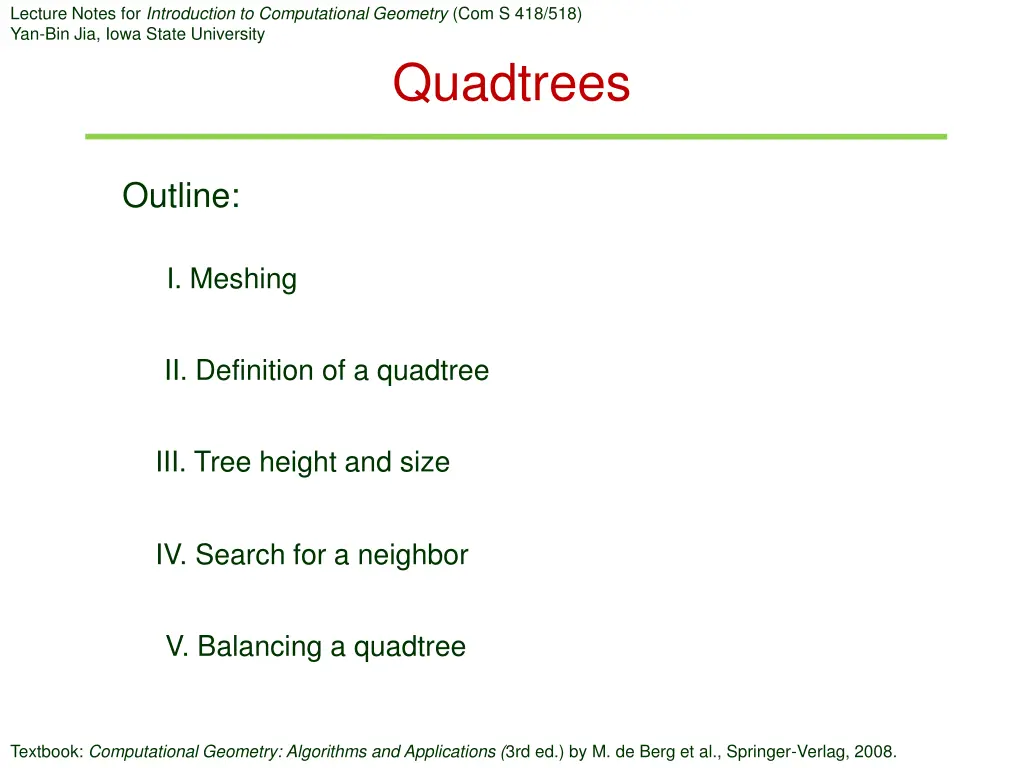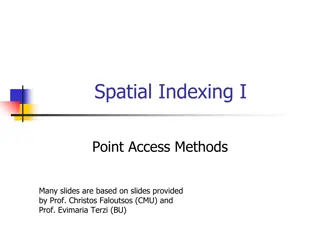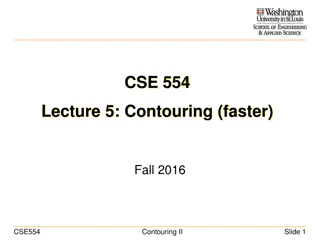
Computational Geometry Lecture Notes
Explore the fundamentals of quadtree structures, mesh generation, triangulation tasks, and Steiner triangulation in computational geometry. Understand the concepts of meshing, quadtree definitions, tree properties, neighbor search, and mesh balancing. Dive into mesh generation domains, triangulation requirements, and Steiner point inclusion. Learn about the role of quadtrees in representing squares and managing square subdivisions with specialized terminology.
Download Presentation

Please find below an Image/Link to download the presentation.
The content on the website is provided AS IS for your information and personal use only. It may not be sold, licensed, or shared on other websites without obtaining consent from the author. If you encounter any issues during the download, it is possible that the publisher has removed the file from their server.
You are allowed to download the files provided on this website for personal or commercial use, subject to the condition that they are used lawfully. All files are the property of their respective owners.
The content on the website is provided AS IS for your information and personal use only. It may not be sold, licensed, or shared on other websites without obtaining consent from the author.
E N D
Presentation Transcript
Lecture Notes for Introduction to Computational Geometry (Com S 418/518) Yan-Bin Jia, Iowa State University Quadtrees Outline: I. Meshing II. Definition of a quadtree III. Tree height and size IV. Search for a neighbor V. Balancing a quadtree Textbook: Computational Geometry: Algorithms and Applications (3rd ed.) by M. de Berg et al., Springer-Verlag, 2008.
I. Meshing Modeling with the finite element methods (FEMs) mechanics-based a finer mesh results in higher accuracy more expensive computation Applications: structural analysis & product design heat transfer fluid flow electromagnetism graphics & gaming, etc. robotics
Mesh Generation Domain: ? ? grid ? where ? = 2? for some integer ? Assumptions: Vertices of components have integer coordinates between 0 and ?. 0 ? Edges of components have four different orientations: 0,? 4,? 2,3? 4.
Triangulation Task Compute a triangular mesh of the square that is conforming (no edge of a triangle is allowed to contain a vertex of another triangle in its interior) violated by 1 Input respecting (component edges must be contained in the union of the edges of the mesh triangles) violated by 2 1 well-shaped (angles of any mesh triangle to be in the range between ? 4 and ? 2) 2 violated by 3 3 non-uniform (mesh should be fine near the edges of components and coarse far away from them) Component
Steiner Triangulation 1 1 component located at (1,1) in a 16 16 grid. Solution: Include some mesh vertices as extra points, which are called Steiner points. Choose these points to form a non- uniform grid. Delaunay triangulation of the eight vertices of the square component and grid s bounding box. Angles too small! 52 triangles (down from 512 uniform triangles)
II. Quadtree A rooted tree in which every node corresponds to a square; every internal node ? has four children which represent the four quadrants of the node s corresponding square. SE SW NE NW Quadtree subdivision
More Terminology Face: a square in the quadtree subdivision (although it may have 4 vertices). ?5 ?6 side ? ?7 Corner: a vertex at the corner of the square. face ?1 ?4 ?2 Side: a line segment connecting two consecutive corners of the square. edge ?1 ?2 ?3 corner Edges of the square: all the edges in the subdivision that are contained in the square s boundary. A side consists of 1 edges. Two squares are neighbors if they share an edge.
Point Storage ?: a set of points. ]: a square to store ?. [??,?? ? = ??,?? Strategy: Recursively split every square that contains > 1 point. If |?| 1 then the quadtree is a single leaf node that stores ? and ?. Otherwise, let ????=??+ ?? ????=??+ ?? 2 2 and define ???= ? ? ??> ???? and ??> ????} ???= ? ? ?? ???? and ??> ????} ???= ? ? ?? ???? and ?? ????} ???= ? ? ??> ???? and ?? ????} Store ???, ???, ???, ??? in the four quadrants ???, ???, ???, ??? of ?, respectively.
Recursive Construction Compute the smallest enclosing square for the point set ?. ?2 ?4 ?5 ?3 ?1 Split the square into four quadrants: NE, NW, SW, and SE. ?8 ?6 ?9 ?7 Partition ? accordingly into four subsets, one for each quadrant. ?10 ?11 Recursively construct quadtrees for each quadrant. Stop at each quadrant containing 1 point. SW SE NW NE ?11 ?10 ?8 ?9 ?7 ?4 ?5 ?6 ?2 ?3 ?1
III. Tree Height ?: side length of the initial square containing ?. ?:minimumdistance between any two points in ?. ? ?+3 Lemma The height of a quadtree for ? is at most log 2. ProofEvery internal node contains 2 points. Its corresponding square must have a diagonal of length ?. The square s side length must be ?/ 2. Meanwhile, when the depth increases by one, the side length of the corresponding square halves. ?/2? ?/ 2 For an internal node at depth ?, the side length becomes ?/2?. The tree height is one greater than the maximum depth of any internal node. Thus, log? ? log? 2 = log? ?+1 ? 2 ?+3 2.
Number of Nodes Theorem 1 A quadtree of height storing ? has ? + 1 ? nodes and can be constructed in ? + 1 ? time. ProofConsider the subtree rooted at an internal node ?.. First, we prove by mathematical induction that ? ? = 1 + 3? ? . # internal nodes # leaves This is true in the base case where the four children ?1,?2, ?3,?4of ? are leaves, i.e., ? ? = 1 and ? ? = 4. ? In the general case, the number of leaves in the subtree is ?1 ?4 ?2 ?3 ? ? = ? ?1 + ? ?2 + ? ?3 + ? ?4 = 3 ? ?1 + ? ?2 + ? ?3 + ? ?4 = 3 ? ? 1 + 4 = 3? ? + 1 + 4 Thus, it suffices to bound ? ? for the size of the quadtree.
Proof (contd) The associated square of any internal node contains 2 points (otherwise, it would be a leaf not an internal node). The squares of all internal nodes at the same depth are disjoint. There are ? points in total distributed among these squares. There are ?/2 internal nodes at the depth. Partitioning of ? points There are ? + 1 ? internal nodes in the tree. (We include 1 in the Big-? in case = 0.) The quadtree has ? + 1 ? nodes. The amount of time spent at an internal node is linear in the number of points in its associated square. ? points are distributed among the squares at the same depth. ?(?) work at each depth. Total construction work ?( + 1 ?).
IV. Neighbor Finding Problem Given a node ? and a direction (north, east, south, or west), find the deepest node ? with depth the depth of ? such that its associate square ?(? ) is a neighbor of the associate square ?(?) of ? in the given direction. Returns nil if no adjacent square in the direction (e.g., ?(?) s edge is part of the edge of the bounding square in that direction). Suppose we want to find the north neighbor of ?. ? is the SE or SW-child of its parent. The north neighbor is the NE or NW-child of the parent. ? is the NE or NW-child of its parent. ?(?) Recursively finds the north neighbor, ?, of the parent node. If ? is an internal node, then the neighbor of ? is its SE or SW-child. If ? is a leaf, then it is the neighbor we are looking for. ?(?)
Searching for the North Neighbor NorthNeighbor(?,?) 1. if ? = root(?) 2. then return nil 3. ? parent(?) 4. if ? is the SW-child of ? 5. then return the NW-child of ? 6. if ? is the SE-child of ? 7. then return the NE-child of ? 8. ? NorthNeighbor(?,?) 9. if ? =nil or ? is a leaf 10. then return ? 11. else if ? is the NW-child of ? 12. then return the SW-child of ? 13. else return the SE-child of ? ? ?(?) The call does not necessarily return a leaf node. To find a leaf node, we need to walk down the quadtree from the returned node, always proceeding to a south-child.
A Bigger Example NorthNeighbor(?,?) ?(?) 1. if ? = root(?) 2. then return nil 3. ? parent(?) 4. if ? is the SW-child of ? 5. then return the NW-child of ? 6. if ? is the SE-child of ? 7. then return the NE-child of ? 8. ? NorthNeighbor(?,?) 9. if ? =nil or ? is a leaf 10. then return ? 11. else if ? is the NW-child of ? 12. then return the SW-child of ? 13. else return the SE-child of ? ?(?) ?(?) ?(?) ?(?) ?(?) ?(?) ? ? ?; returns ? (leaf) NE NW SE ? NorthNeighbor(?,?) ? SW ? ?; returns ? (leaf) NorthNeighbor(?,?) ? ? ? ?; returns ? (SW-child of ?) NorthNeighbor(?,?) ? returns ? NorthNeighbor(?,?) ?
V. Balanced Quadtree A quadtree subdivision is balanced if any two neighboring squares differ by a factor of one or two in size (as measured by the side length not by area). This implies that any two leaves whose squares are neighbors can differ at most one in depth. depth 4 depth 1 Unbalanced subdivision and Corresponding quadtree.
Example balancing NE NW SE SW
Balancing Algorithm BalanceQuadTree(?) 1. insert all the leaves of ? into a linear list 2. while is not empty 3. do remove a leaf ? from 4. if ?(?) has to be split 5. then make ? an internal node with four new leaves 6. if ? stores a point 7. then stores it in the correct new leaf 8. insert the four new leaves into 9. if ?(?) had neighbors that now need to be split 10. then insert them into
First Issue to Settle On line 4 of the algorithm, how to check if a leaf ?(?)needs to be split? Check if ?(?) has a neighboring square less than half its size. Employ the earlier introduced neighbor finding algorithm. north neighbor of ? Such a small neighbor in the north exists iff NorthNeighbor(?,?) returns a node that has a SW- or SE-child that is not a leaf. its SW-child its grandchild (as a neighbor of ?(?) with of its size) ?(?) BalanceQuadTree(?) insert all the leaves of ? into a linear list while is not empty do remove a leaf ? from if ?(?) has to be split then make ? an internal node with four new leaves if ? stores a point then stores it in the correct new leaf insert the four new leaves into if ?(?) had neighbors that now need to be split then insert them into 1. 2. 3. 4. 5. 6. 7. 8. 9. 10.
Second Issue to Settle BalanceQuadTree(?) insert all the leaves of ? into a linear list while is not empty do remove a leaf ? from if ?(?) has to be split then make ? an internal node with four new leaves if ? stores a point then stores it in the correct new leaf insert the four new leaves into if ?(?) had neighbors that now need to be split then insert them into 1. 2. 3. 4. 5. 6. 7. 8. 9. 10. On line 9, check if ?(?), already split, had a neighbor that needs to be split. Again use the neighbor finding algorithm. Such a neighbor exists to the north iff NorthNeighbor(?,?) returns a node corresponding to a square larger than ?(?). Such a neighbor would be more than twice the size of each of the four children from splitting of ? on line 5. ?(?)
Cost of Balancing Theorem 2 Let ? be a quadtree with ? nodes. Then the balanced version of ? has ?(?) nodes and can be constructed in ? + 1 ? time. ProofOmitted.
From Quadtrees to Meshes Mesh generation from a set of disjoint polygons ? whose vertices have integer coordinates and whose edges makes angles 0,? the ?-axis. 4,? 2,3? 4 with Algorithm 1. Construct a quadtree subdivision of the polygon vertices. Stop splitting a square when it is no longer intersected by a polygon edge, or when it has unit size. 0 ? 2. Balance the quadtree subdivision. 3. Triangulate the balanced quadtree subdivision (adding Steiner points).
Other Applications of Quadtrees Image processing Patch tree for a pebble (based on the Gauss map) Point location Collision detection Data storage & visualization Computational fluid dynamics Quadtree


